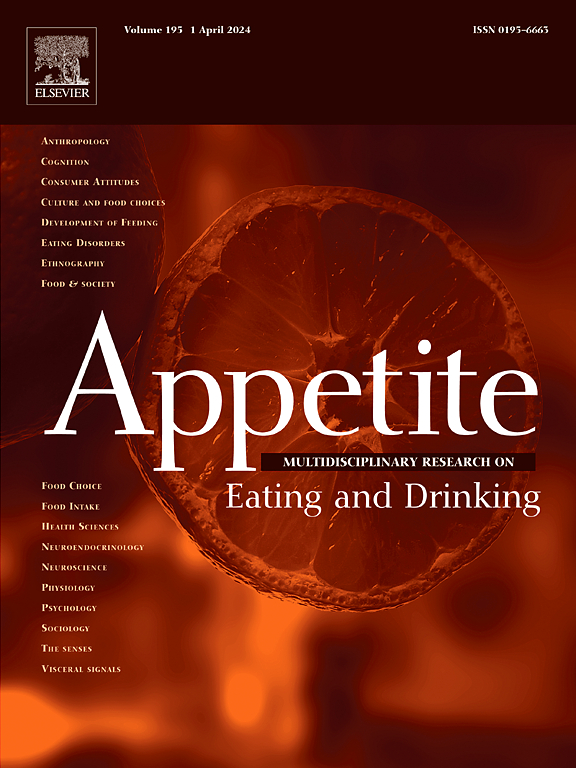高糖、高钠和高饱和脂肪食品的包装正面标签:一项随机实验。
IF 3.8
2区 医学
Q1 BEHAVIORAL SCIENCES
引用次数: 0
摘要
背景:包装正面标签(FOPLs)表明高含量的关注营养素(即,添加糖,钠和饱和脂肪)有可能提高消费者对食品健康的认识。美国食品和药物管理局(FDA)测试了潜在的fopl,包括“High-In”设计。方法:参与者(N=3,931)被随机分配到没有图标的对照“High-In”FOPL(基于FDA设计)或4个带有图标的“High-In”FOPL中的一个:(1)放大镜,(2)黑色圆圈中的感叹号,(3)白色圆圈中的感叹号,(4)带有感叹号的多个标签(每种营养素一个)。研究人员向参与者展示了三种冷冻食品,分别富含1、2或3种值得关注的营养物质,并根据指定的条件贴上了标签。参与者被要求选择(1)最健康和最不健康的产品,(2)添加糖、钠和饱和脂肪含量高的产品。还对每个标签评估了食用高营养食物的感觉障碍。结果:对照和图标标签在识别最健康和最不健康产品方面没有显著差异。然而,与所有其他条件相比,多标签感叹号条件提高了对高钠和高饱和脂肪食品的识别(分别为78% vs. 68-72%和85% vs. 76-80%)(结论:在单独标签中列出每种“高”营养成分的FOPLs可能比组合所有营养成分的标签更能帮助消费者识别高营养成分的食品。本文章由计算机程序翻译,如有差异,请以英文原文为准。
“High-In” front-of-package labeling of foods high in added sugars, sodium, and saturated fat: A randomized experiment
Background
Front-of-package labels (FOPLs) indicating high content of nutrients of concern (i.e., added sugars, sodium, and saturated fat) have the potential to improve consumer understanding of a food's healthfulness. The Food and Drug Administration (FDA) tested potential FOPLs, including “High-In” designs.
Methods
Participants (N = 3,931) were randomized to a control “High-In” FOPL with no icon (based on an FDA design) or 1 of 4 “High-In” FOPLs with icons: a (1) magnifying glass, (2) exclamation mark in a black circle, (3) exclamation mark in a white circle, and (4) multiple labels (one for each nutrient) with exclamation marks. Participants were shown 3 frozen meals, high in 1, 2, or 3 nutrients of concern, labeled according to assigned condition. Participants were asked to select the (1) healthiest and least healthy products and (2) the product(s) high in each of added sugars, sodium, and saturated fat. Perceived discouragement of consuming a food high in nutrients of concern was also assessed for each label.
Results
There were no significant differences between the control and icon labels in identifying the healthiest or least healthy products. However, the multilabel-exclamation condition improved identification of high-sodium and high-saturated-fat items compared to all other conditions (78 % vs. 68–72 % and 85 % vs. 76–80 %, respectively) (Ps < 0.05). The multilabel-exclamation condition was also perceived as significantly more discouraging of consuming a high-in food than all other conditions.
Conclusion
FOPLs that list each “high-in” nutrient in separate labels may better help consumers identify foods high in nutrients of concern than a label combining all nutrients.
求助全文
通过发布文献求助,成功后即可免费获取论文全文。
去求助
来源期刊

Appetite
医学-行为科学
CiteScore
9.10
自引率
11.10%
发文量
566
审稿时长
13.4 weeks
期刊介绍:
Appetite is an international research journal specializing in cultural, social, psychological, sensory and physiological influences on the selection and intake of foods and drinks. It covers normal and disordered eating and drinking and welcomes studies of both human and non-human animal behaviour toward food. Appetite publishes research reports, reviews and commentaries. Thematic special issues appear regularly. From time to time the journal carries abstracts from professional meetings. Submissions to Appetite are expected to be based primarily on observations directly related to the selection and intake of foods and drinks; papers that are primarily focused on topics such as nutrition or obesity will not be considered unless they specifically make a novel scientific contribution to the understanding of appetite in line with the journal's aims and scope.
 求助内容:
求助内容: 应助结果提醒方式:
应助结果提醒方式:


